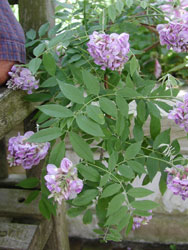Resource Library
Plant of the Week: Wisteria, American
The University of Arkansas System Division of Agriculture does not promote, support or recommend plants featured in "Plant of the Week." Please consult your local Extension office for plants suitable for your region.
Plant of the Week
American Wisteria
Latin: Wisteria frutescens

Vines can be big and fast growing, intent on world domination. Think kudzu. Think wisteria. But, even fast growers like wisteria can be managed if some up-front choices are made. One of these choices involves planting the American wisteria (Wisteria frutescens), not its wild, overly vigorous kin Wisteria floribunda from Japan.
American wisteria is a native deciduous vine found in wet thickets throughout the southeastern states in the gulf coastal plain. It can grow twining vines 20 to 30 feet long, but it’s not as vigorous as Japanese wisteria, which grows faster and can reach heights of 60 feet or more.
Leaves are dark green, compound with nine to 15 leaflets. Fragrant blue, lavender or white flowers appear after the leaves and are produced in trusses that are typically 5 inches long. Individual pea-shaped flowers are larger on the American wisteria than on its Asian counterparts, but the overall showiness in bloom is not as great because the trusses are smaller and they appear after the leaves emerge.
Wisteria was named to honor Caspar Wistar (1761-1818), a Philadelphia doctor who taught anatomy using wax-infused corpses, a technique he developed. Wistar, whose name botanist Thomas Nuttall misspelled when he named the plant, was an early advocate of immunization in America. He was also an active member of the American Philosophical Society and supported the efforts of excavating the first mammoth skeleton.
The famous artist Charles Peale (1741-1827) is best known for his iconic paintings of George Washington, Thomas Jefferson and other luminaries of his day, but he was also keenly interested in natural history. He became interested in mammoths after being asked to illustrate some of the giant bones found in a salt lick along the Ohio River. In 1801, Peale and his sons organized the first scientific expedition to recover a complete skeleton in boggy ground in New York.
The American wisteria does best in a fertile, moderately moist soil. It flowers best in full sun but will bloom in shade. Plants are hardy from zones 5 through 9.
American wisteria makes a good vine for planting over gateway arches, for topping pergolas and even training along fences. Like other vigorous vines it should be supported by a strong trellis. Ideally, the trellis should be isolated from nearby trees or other structures on which it might escape.
The correct way to prune wisterias depends on how they are being grown. If the vine is planted on a chain link fence, prune it in the winter each year to remove excessively long shoots and limit its spread. If side shoots are removed, leave a couple of buds at the base of each branch for flowering.
If the vine tops a pergola or other structure, prune the vine back hard every year after flowering to keep it under control. In either case, set limits in advance on how large the vine will be allowed to get and then stick to them. Some pruning will be needed each year to maintain size.
By: Gerald Klingaman, retired
Extension Horticulturist - Ornamentals
Extension News - April 10, 2009
The University of Arkansas System Division of Agriculture does not maintain lists of retail outlets where these plants can be purchased. Please check your local nursery or other retail outlets to ask about the availability of these plants for your growing area.